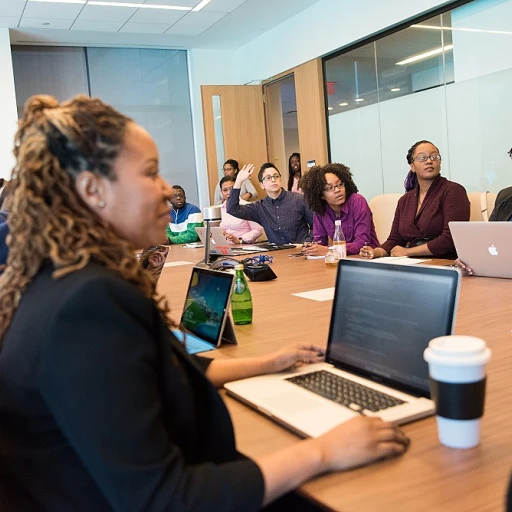Understanding the Candidate Experience
Decoding Candidates' Perspectives
At the heart of the hiring process lies what many deem as the linchpin of talent acquisition: the candidates' journey. It encapsulates every interaction potential employees have with a company, from their initial engagement to the final offer letter. Understanding this journey is indispensable for any organization striving to attract and retain top talent in today's competitive landscape. To truly enhance this experience, it's crucial to dive into what candidates undergo during their job search and application process. This isn't just about the transactional steps of applying or interviewing; it’s about every touchpoint reflecting the company’s values and providing the candidate with a holistic view of what working there would entail. Several key aspects play significant roles in how this experience is perceived. Firstly, the clarity and accessibility of job descriptions can massively influence how candidates feel about a position. Linked seamlessly with application processes, these descriptions either invite or deter interest. Moreover, a seamless interview experience, discussed in the subsequent sections, can often be a turning point for candidates deciding between offers. Lastly, assessing the effectiveness of your candidate journey efforts cannot be overlooked. Measuring success isn’t an end in itself but provides insights into areas that need tweaking. The journey is continuously evolving as organizations learn from real-life examples and case studies, which we'll delve into, offering practical insights on what has worked and what hasn’t in various industries. Overall, focusing on enhancing the candidates’ experience isn’t just about filling a position; it’s about building a relationship. From precise job descriptions to impactful interviews and leveraging technology, every element contributes to a candidate's perception and, ultimately, your brand’s reputation.The Role of Job Descriptions and Applications
Crafting Compelling Job Descriptions
Creating effective job descriptions is a fundamental aspect of enhancing the job seeker's journey in talent acquisition. A well-crafted job description not only attracts qualified candidates but also sets the tone for their entire experience with the organization. It's the first formal communication between a company and potential employees, making it crucial to communicate the right message. To make job descriptions truly compelling, they need to be clear, concise, and reflective of the company culture. Avoid using jargon and focus on what matters most to the candidate—responsibilities, required skills, and what they can expect from the role. Transparency is key; candidates appreciate honesty about the challenges they might face and the opportunities available for growth. Moreover, inclusivity should be a priority when drafting job descriptions. Using gender-neutral language and highlighting commitment to diversity and inclusion can make your postings appeal to a broader audience, ensuring that you’re attracting talent from diverse backgrounds.Optimizing the Application Process
An often overlooked but critical component of candidate experience is the application process itself. Simplifying this process can significantly enhance the job seeker's journey, as a cumbersome application can deter even the most eager prospects. Streamlining the application process involves minimizing the steps required to complete an application. Many candidates abandon applications due to repetitive requests, such as continually uploading a resume while also manually entering the same information. Integrating modern Applicant Tracking Systems (ATS) can alleviate this, allowing candidates to have a smoother experience by enabling auto-fill features or integrations with platforms like LinkedIn. Furthermore, providing guidance and clear instructions throughout the application can reduce candidate frustration. Visual progress indicators and the ability to save progress can make a huge difference in keeping applicants engaged and willing to complete the process. Enhancing the candidate experience starting with job descriptions and optimizing the application process sets the stage for success down the line. As we delve further into improving these aspects, we also consider the importance of the interview process in maintaining a positive candidate journey.Improving the Interview Process
Optimizing Engagement Through Interviews
The interview stage is often regarded as one of the most critical phases in a talent acquisition strategy. It serves as an arena where both employers and candidates have the opportunity to assess mutual compatibility. A well-structured interview process not only determines the best fit for the role but also significantly enhances the overall experience for the job seeker. Many organizations strive to refine their interview techniques to build meaningful connections and showcase their company culture effectively. Candidates who resonate with a transparent and enthusiastic representation of a potential workplace are likely to retain a positive outlook towards the hiring company, even if the outcome isn't favorable. It's essential to keep in mind the art of asking relevant yet thought-provoking questions that can gauge both skills and personality. Interviewers should be well-prepared, ensuring that every interaction is respectful of the candidate's time and efforts. Feedback, an often overlooked element, should be prompt and constructive to keep communication channels open and effective. This respectful dialogue not only assists candidates in growth but also projects a professional image of the organization. Implementing structured interview formats can be beneficial. By creating a consistent framework, companies ensure that every candidate undergoes a fair and unbiased evaluation focused on their potential workplace compatibility. This helps in discerning the nuances of a candidate's ethos, aligning with what was discussed in role descriptions and applications in earlier parts. Moreover, the use of technology can streamline and enhance the interview process. Leveraging virtual interviews can facilitate seamless interactions, respecting geographical limitations while ensuring an intimate and customized interview experience. For those interested in understanding the effectiveness of these processes, examining talent acquisition metrics can provide valuable insights. Finally, integrating feedback loops and reflecting on candidate experiences post-interview can help organizations continually improve their approach. Remember, each interaction from job descriptions to interviews is a building block in crafting a reputable and attractive employer brand.Leveraging Technology in Recruitment
Harnessing Digital Tools for a Seamless Hiring Experience
In the evolving landscape of talent acquisition, leveraging technology has become a cornerstone for enhancing the candidate experience. As we delve into the intricacies of the recruitment process, it's essential to recognize how digital tools can streamline and elevate each stage, from initial contact to the final offer.
One of the most significant advantages of using technology in recruitment is the ability to automate repetitive tasks, allowing recruiters to focus on more strategic aspects of hiring. Applicant tracking systems (ATS) can efficiently manage candidate data, reducing the administrative burden and ensuring that no potential hire slips through the cracks. This not only speeds up the process but also ensures a more organized and professional interaction with candidates.
Moreover, technology can enhance communication, a critical component of the candidate experience. Automated emails and chatbots can provide timely updates and responses, keeping candidates informed and engaged throughout their journey. Personalized communication tools can also help tailor messages to candidates, making them feel valued and respected.
Virtual interviews have also become a game-changer, especially in a world where remote work is increasingly common. Video conferencing tools offer flexibility for both candidates and recruiters, breaking geographical barriers and allowing for a broader talent pool. This approach not only saves time and resources but also aligns with the preferences of modern job seekers who value convenience and efficiency.
As we discussed in earlier sections, understanding the candidate experience is crucial, and technology plays a vital role in gathering insights. Feedback tools and surveys can be integrated into the recruitment process to collect data on candidate satisfaction, helping organizations refine their strategies and improve overall experiences.
In summary, the strategic use of technology in recruitment not only enhances efficiency but also significantly improves the candidate experience. By embracing digital solutions, organizations can create a more engaging, transparent, and streamlined hiring process that resonates with today's job seekers.
Measuring Candidate Experience Success
Identifying Key Performance Indicators
Measuring the success of candidate experience initiatives is a crucial step in refining your talent acquisition strategy. To gauge how well your recruitment process is performing from the perspective of the job seekers, identifying key performance indicators (KPIs) is essential. These metrics can provide actionable insights into what’s working and what needs improvement. One of the most telling factors in candidate experience is the offer acceptance rate, which reveals whether your recruitment process and company culture are enticing to potential employees. Employment offer rejection rates can be equally enlightening. High rejection rates may indicate issues related to the job description, compensation, or company reputation, as discussed in previous sections. Another important KPI is the time to hire. Streamlining the interview and decision-making process is pivotal in maintaining a positive candidate experience. Prolonged wait times can cause candidates to lose interest or accept offers from competitors. Improving these aspects can enhance your recruitment timeline and overall reputation as a prospective employer. You should also consider gathering qualitative feedback, which can offer a deeper understanding of candidate sentiments. Implementing survey tools and interviews post-process can reveal specific areas of frustration or satisfaction within the candidate journey, enabling more targeted improvements. By regularly analyzing these metrics, you can tailor your talent acquisition efforts to foster a better candidate experience, ultimately attracting and retaining the right talent for your organization.Real-Life Examples and Case Studies
Illustrating Success Through Real-Life Scenarios
In the realm of talent acquisition, understanding the candidate experience is not just theoretical—it's a practical endeavor that many companies have successfully navigated. By examining real-life examples, we can glean valuable insights into what works and what doesn't.
Take, for instance, a leading tech company that revamped its job descriptions and applications. They realized that their initial job postings were overly technical and intimidating for potential candidates. By simplifying the language and focusing on the core responsibilities and growth opportunities, they saw a significant increase in applications from diverse talent pools.
Another example can be found in a healthcare organization that transformed its interview process. Initially, their interviews were long and cumbersome, leading to candidate fatigue. By streamlining the process and incorporating structured interviews, they not only improved the candidate experience but also enhanced the quality of their hires.
Moreover, a retail giant leveraged technology in recruitment by implementing AI-driven chatbots to handle initial candidate queries. This not only freed up recruiters' time but also provided candidates with instant responses, improving their overall experience.
These examples underscore the importance of continually measuring candidate experience success. By collecting feedback and analyzing data, these companies were able to make informed adjustments, leading to better outcomes for both the candidates and the organization.
Real-life case studies such as these demonstrate the tangible benefits of a well-thought-out talent acquisition strategy, offering a roadmap for other organizations looking to enhance their own candidate experiences.



